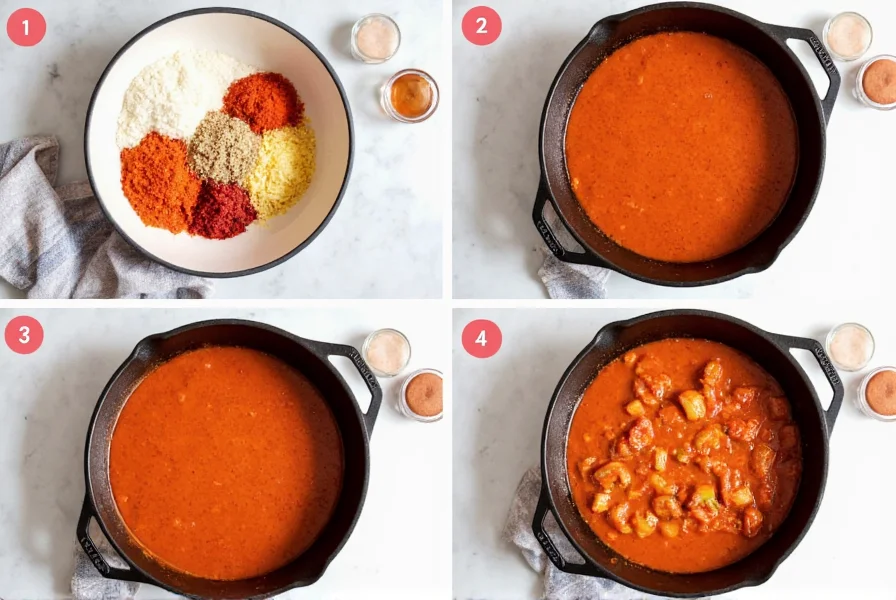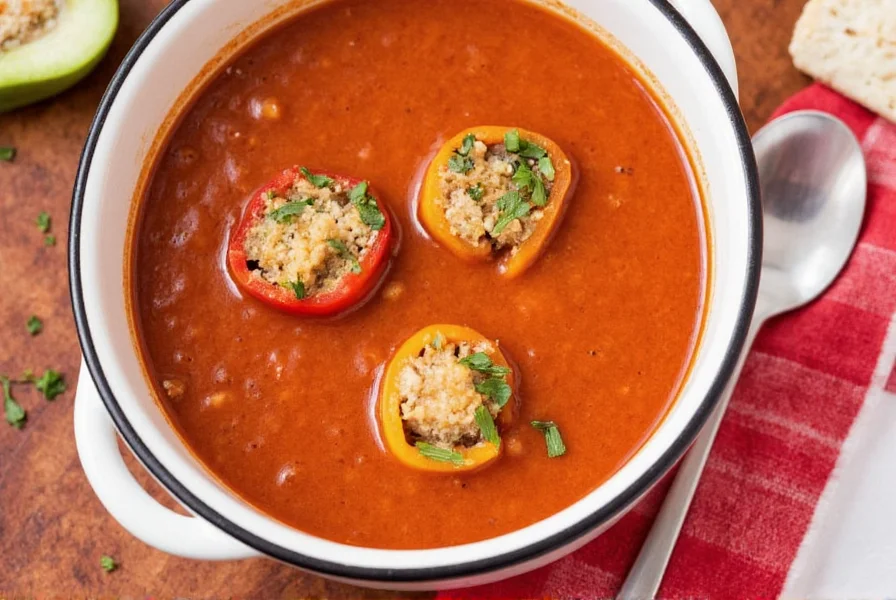Transforming traditional stuffed peppers into soup format delivers all the comforting flavors with significantly less effort. This adaptation maintains the core components—bell peppers, ground meat, rice, and tomato base—but reimagines them as a satisfying soup that's perfect for weeknight dinners or meal prep. Unlike the labor-intensive original, stuffed pepper soup recipes typically require just one pot and under 45 minutes from start to finish.
Why Choose Soup Over Traditional Stuffed Peppers?
The soup variation solves several pain points of the classic dish. Traditional stuffed peppers demand precise rice cooking, careful filling, and extended baking time—often resulting in overcooked peppers or undercooked rice. Stuffed pepper soup recipes eliminate these frustrations while preserving the dish's nutritional profile and comforting essence. You'll achieve consistent texture throughout, easier portion control, and simplified reheating without compromising on the savory-sweet pepper flavor that defines this comfort food.
Essential Ingredients for Perfect Stuffed Pepper Soup
The foundation of any exceptional easy stuffed pepper soup recipe starts with quality ingredients. While variations exist, these components form the backbone of authentic flavor:
| Core Ingredient | Function | Substitution Options |
|---|---|---|
| Bell peppers (mixed colors) | Provides sweetness and texture | Use all green for sharper flavor |
| Ground beef or turkey | Creates savory depth | Lentils for vegetarian version |
| Long-grain white rice | Thickens soup naturally | Cauliflower rice for keto option |
| Diced tomatoes with juice | Forms acidic base | Crushed tomatoes for smoother texture |
| Beef or vegetable broth | Builds flavor foundation | Water with additional seasonings |
Step-by-Step Preparation Guide
Follow this method for foolproof stuffed pepper soup from scratch that delivers restaurant-quality results:
- Sauté aromatics: Cook onions and garlic in olive oil until translucent (3-4 minutes)
- Brown meat: Add ground meat, breaking into small pieces until fully cooked
- Add peppers: Stir in chopped bell peppers and cook until slightly softened (5 minutes)
- Build broth: Pour in tomatoes, broth, rice, and seasonings (1½ tsp paprika, 1 tsp oregano)
- Simmer: Cover and cook on medium-low for 20-25 minutes until rice is tender
- Finish: Stir in fresh parsley and adjust salt/pepper to taste

Popular Recipe Variations
Adapt this versatile base to suit dietary needs with these tested healthy stuffed pepper soup variations:
Classic Beef Version
Use 1 lb lean ground beef, 1 cup long-grain rice, and 4 cups beef broth. For richer flavor, add 2 tbsp tomato paste when sautéing vegetables. This traditional stuffed pepper soup recipe serves 6 and contains approximately 320 calories per serving.
Vegetarian Alternative
Substitute meat with 1 cup cooked lentils and use vegetable broth. Add ½ cup quinoa with the rice for complete protein. Boost umami with 2 chopped mushrooms sautéed with the peppers. This vegetarian stuffed pepper soup recipe maintains the hearty texture while being completely plant-based.
Keto-Friendly Option
Eliminate rice and double the bell peppers. Use 1 cup riced cauliflower added during the last 5 minutes of cooking. Increase broth to 5 cups and add ½ cup heavy cream for richness. This keto stuffed pepper soup variation stays under 8g net carbs per serving while preserving the dish's comforting essence.

Avoiding Common Mistakes
Even experienced cooks encounter pitfalls with stuffed pepper soup cooking time and technique. Prevent these frequent errors:
- Overcooked peppers: Add half the peppers at the beginning and the rest during the last 10 minutes of cooking
- Mushy rice: Use long-grain rice and avoid over-stirring during simmering
- Bland flavor: Bloom spices in oil before adding liquids—cook paprika and oregano for 30 seconds with the meat
- Thin broth: Simmer uncovered for the final 5 minutes to concentrate flavors if needed
Storage and Reheating Tips
Proper handling ensures your stuffed pepper soup storage maintains quality. Cool completely before storing in airtight containers:
- Refrigeration: Keeps for 4-5 days—flavors deepen overnight
- Freezing: Store up to 3 months; omit dairy if adding cream
- Reheating: Warm on stove over medium-low heat, adding broth if too thick
- Meal prep: Portion into single servings for quick lunches
Nutritional Benefits
Beyond comfort food appeal, quality stuffed pepper soup recipes deliver notable nutrition. Bell peppers provide 169% of daily vitamin C per cup, while tomatoes contribute lycopene. The combination of lean protein, complex carbohydrates, and vegetable fiber creates balanced meals that satisfy without excess calories. For those monitoring sodium, using low-sodium broth and diced tomatoes lets you control salt content while maintaining flavor depth.
Frequently Asked Questions
Can I make stuffed pepper soup without rice?
Yes, you can substitute rice with quinoa, cauliflower rice, or barley. For grain-free versions, increase the bell peppers and add diced zucchini for texture. Omitting grains entirely works well in keto variations, though you may need to adjust broth quantity as rice normally absorbs liquid during cooking.
How do I prevent peppers from becoming mushy in soup?
Add half the peppers at the beginning for flavor base and the remaining half during the last 10 minutes of cooking. This two-stage approach preserves texture while ensuring full flavor development. Using slightly underripe peppers (firmer texture) also helps maintain distinct pepper pieces throughout the soup.
What's the best meat for stuffed pepper soup?
Ground turkey provides lean protein with mild flavor that lets vegetable notes shine, while beef offers richer, more traditional taste. For vegetarian versions, lentils or textured vegetable protein work well. Avoid strongly flavored meats like lamb that can overpower the delicate pepper sweetness essential to authentic stuffed pepper soup recipes.
Can I use frozen bell peppers for stuffed pepper soup?
Fresh peppers yield superior texture and flavor, but frozen can work in a pinch. Thaw completely and pat dry before use to prevent excess water. Expect slightly softer texture, so add frozen peppers later in the cooking process. For best results, use frozen peppers within 3 months of freezing and avoid refreezing after thawing.











 浙公网安备
33010002000092号
浙公网安备
33010002000092号 浙B2-20120091-4
浙B2-20120091-4